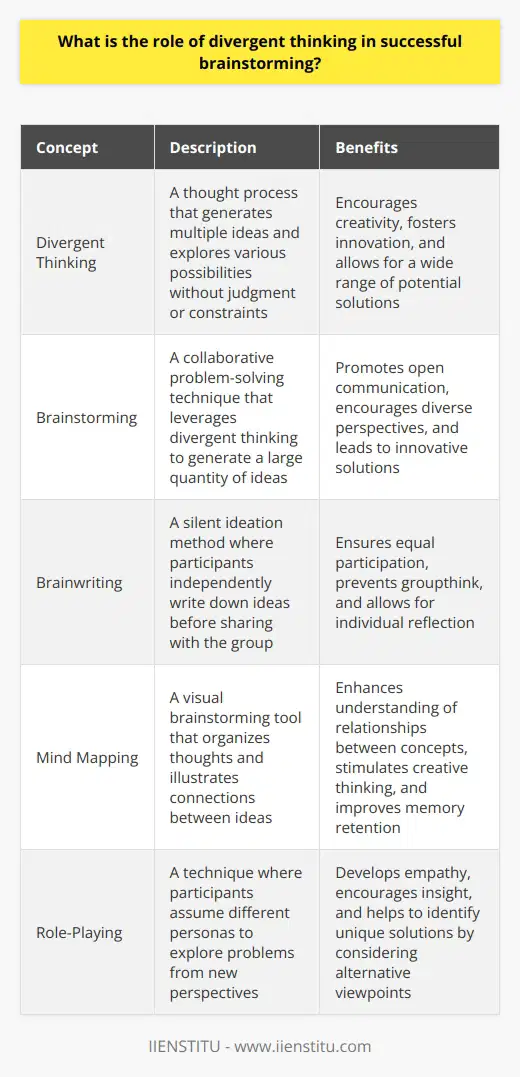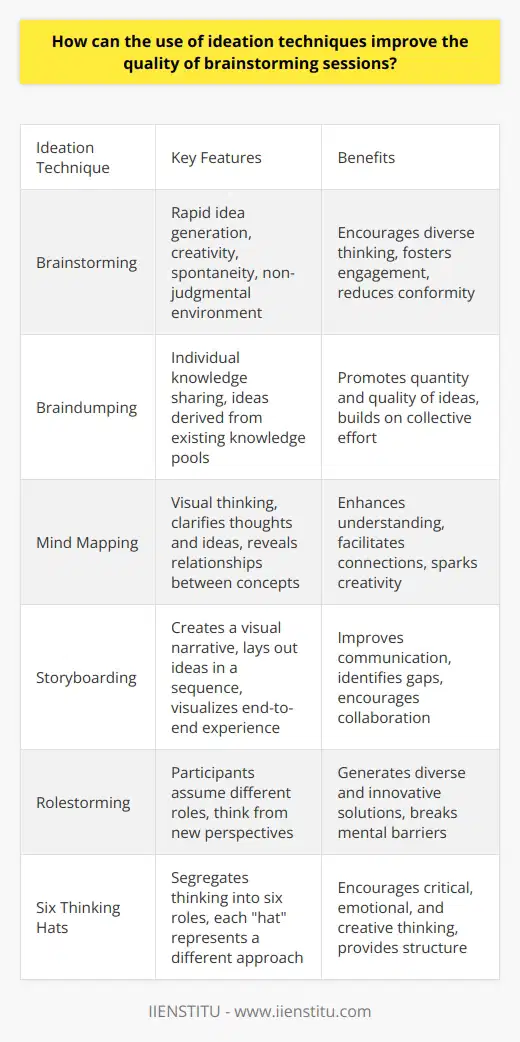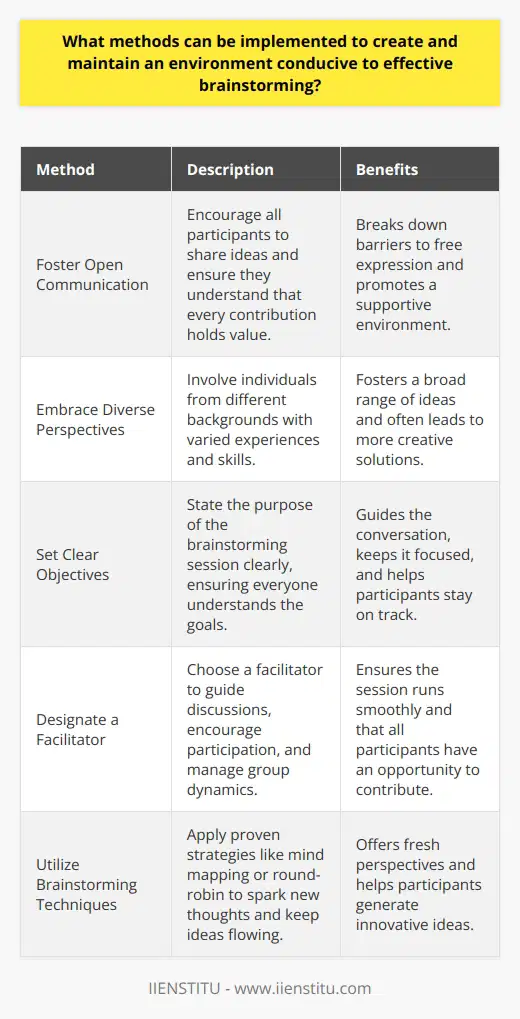
I. Introduction to Brainstorming: A Comprehensive Guide to Ideation Techniques
Brainstorming, a term coined by Alex Faickney Osborn in the 1940s, has become a ubiquitous tool in the realms of business, education, and personal development. As an advertising executive, Osborn recognized the need for a systematic approach to creative problem-solving and idea generation (Osborn, 1963). His brainchild, the brainstorming process, has since evolved into a multifaceted methodology that spans various techniques and strategies.
In my personal journey as an entrepreneur and creative professional, I have witnessed firsthand the transformative power of effective brainstorming. From the early days of my startup, where our small team huddled around whiteboards, scribbling ideas and feeding off each other's energy, to the more structured sessions I now facilitate for clients, brainstorming has been a constant companion in my quest for innovation.
This article serves as a comprehensive guide to the world of brainstorming, exploring its core principles, various techniques, and best practices. Whether you're a seasoned facilitator or a curious individual looking to harness the power of collaborative ideation, this guide will provide you with the tools and insights needed to navigate the exciting landscape of brainstorming.
II. Understanding the Process of Brainstorming
A. Breakdown of Brainstorming elements
At its core, brainstorming is a process that involves the generation of a large quantity of ideas in a short period, without the constraint of immediate judgment or criticism (Isaksen & Gaulin, 2005). This free-flowing, non-judgmental approach is designed to tap into the collective creativity of a group, encouraging participants to build upon each other's ideas and explore new avenues of thought.
The key elements of a successful brainstorming session include:
1- Clear problem definition: Before diving into idea generation, it's crucial to establish a well-defined problem statement or objective. This helps focus the group's efforts and ensures that the ideas generated are relevant and targeted.
2- Diverse participants: Assembling a group with varied backgrounds, experiences, and perspectives can greatly enhance the richness and depth of the ideas generated. Diversity fosters cross-pollination of thoughts and encourages participants to approach the problem from different angles.
3- Suspension of judgment: One of the cardinal rules of brainstorming is to withhold criticism during the idea generation phase. This creates a safe space for participants to share their thoughts freely, without fear of being shot down or ridiculed.
4- Quantity over quality: The emphasis in brainstorming is on generating a large volume of ideas, rather than seeking perfection. The rationale behind this is that the more ideas generated, the higher the likelihood of stumbling upon innovative and viable solutions.
B. The role of open discussions and constructive criticism in Brainstorming
While the initial stages of brainstorming prioritize the free flow of ideas, the process doesn't end there. Once a substantial pool of ideas has been generated, the group moves into a phase of open discussion and constructive criticism.
This is where the real magic of collaboration happens. Participants engage in a dialogue, building upon each other's ideas, identifying potential challenges, and refining the most promising concepts. The key here is to maintain a balance between respectful critique and encouragement.
In my experience, facilitating open discussions requires a delicate touch. It's important to create an environment where participants feel heard and valued, while also gently guiding the conversation toward productive outcomes. Techniques such as active listening, paraphrasing, and asking probing questions can help ensure that all voices are heard and that the discussion remains focused and constructive.
C. The importance of a relaxed, non-judgmental environment
One of the most critical factors in the success of a brainstorming session is the creation of a relaxed and non-judgmental atmosphere. When participants feel psychologically safe to express their ideas without fear of ridicule or negative consequences, they are more likely to engage fully and contribute their unique perspectives (Edmondson, 1999).
As a facilitator, it's essential to set the tone from the outset, emphasizing that all ideas are welcome and that the session is a judgment-free zone. Establishing ground rules, such as avoiding criticism, encouraging wild ideas, and building upon each other's contributions, can help foster a supportive and collaborative environment.
In my early days of facilitating brainstorming sessions, I learned this lesson the hard way. During one particularly memorable session, a participant shared an idea that was met with laughter and dismissive comments from some of their colleagues. The individual immediately withdrew, and the energy in the room shifted palpably. From that moment on, I made it a point to vigilantly guard against any signs of judgment or ridicule, ensuring that every participant felt valued and respected.
III. Techniques and Strategies for Effective Brainstorming
A. Overview of various Brainstorming strategies
Over the years, a wide array of brainstorming techniques and strategies have emerged, each designed to stimulate creativity and facilitate effective ideation. Some of the most popular and effective methods include:
1- Brainwriting: In this silent brainstorming technique, participants write down their ideas on sticky notes or cards, which are then shared and built upon by others. This approach ensures equal participation and prevents the domination of the discussion by more vocal individuals (Paulus & Korde, 2013).
2- Mind Mapping: This visual brainstorming method involves creating a diagram that radiates from a central theme or problem, with related ideas branching off from it. Mind mapping helps participants see connections between ideas and encourages a structured yet creative exploration of the topic at hand (Buzan & Buzan, 2006).
3- Reverse Brainstorming: Also known as "negative brainstorming," this technique involves generating ideas for how to cause the problem, rather than solve it. By exploring the inverse, participants can gain new insights and identify potential pitfalls to avoid (Schwaninger, 2008).
4- SCAMPER: This acronym stands for Substitute, Combine, Adapt, Modify, Put to another use, Eliminate, and Reverse. SCAMPER provides a structured framework for generating ideas by prompting participants to consider the problem from various angles (Eberle, 1996).
B. Suitability of different strategies for different situations
While all brainstorming techniques share the common goal of generating ideas, not every strategy is suited to every situation. Factors such as group size, participant dynamics, time constraints, and the nature of the problem can all influence the choice of brainstorming method.
For example, brainwriting might be more appropriate for larger groups or those with introverted participants, as it allows for equal contribution without the pressure of speaking up in front of others. On the other hand, a more free-flowing, verbal approach like traditional brainstorming might be better suited to smaller, more extroverted teams tackling a highly creative challenge.
In my consulting work, I often find myself adapting my facilitation style and choice of brainstorming technique to the specific needs and dynamics of the group. By being attuned to these factors and having a diverse toolkit of strategies at my disposal, I'm able to create customized brainstorming experiences that maximize the potential for innovative thinking.
C. Tips for running successful Brainstorming sessions
Running a successful brainstorming session requires careful planning, skillful facilitation, and a commitment to creating an environment conducive to creative thinking. Here are some key tips I've learned over the years:
1- Set clear objectives: Begin the session by clearly articulating the problem statement or challenge at hand. Provide any necessary background information and establish specific goals for the brainstorming session.
2- Establish ground rules: Create a set of guidelines that promote open, respectful communication and discourage judgment or criticism. Emphasize that all ideas are welcome and that the goal is to generate as many ideas as possible.
3- Encourage diverse perspectives: Foster an inclusive environment where all participants feel valued and heard. Actively seek out input from quieter individuals and encourage participants to build upon each other's ideas.
4- Manage time effectively: Set a clear timeline for the session and use techniques like time-boxing to keep the discussion on track. Make sure to allocate sufficient time for both idea generation and the discussion and refinement of ideas.
5- Capture and document ideas: Use whiteboards, flip charts, or digital tools to record ideas as they emerge. This not only helps keep the session organized but also provides a valuable record for later reference and follow-up.
6- Maintain momentum: Keep the energy level high by using icebreakers, energizers, and creative prompts. If the discussion starts to lag or veer off-course, gently guide it back on track and inject fresh stimulus to reignite the creative spark.
Facilitating successful brainstorming sessions is both an art and a science. It requires a blend of interpersonal skills, strategic thinking, and a deep understanding of creative problem-solving processes (Isaksen & Gaulin, 2005). Investing in facilitation training or online certification courses can be a valuable way to refine one's skills in this area.
IV. Benefits of Brainstorming in Creative Processes
A. Benefits for individuals
Engaging in brainstorming can offer numerous benefits for individuals, both in terms of their creative output and their personal development. Some of the key advantages include:
1- Boosting creativity: Brainstorming provides a structured framework for individuals to flex their creative muscles and explore new avenues of thought. By suspending judgment and embracing a free-flowing approach to idea generation, individuals can tap into their innate creativity and come up with novel solutions (Osborn, 1963).
2- Enhancing problem-solving skills: Regular participation in brainstorming sessions can help individuals hone their problem-solving abilities. By engaging in the process of defining problems, generating ideas, and critically evaluating solutions, individuals develop a more systematic and effective approach to tackling challenges.
3- Fostering a growth mindset: Brainstorming promotes a growth mindset by emphasizing the value of exploration, experimentation, and learning from failures. By embracing the notion that all ideas are worth considering and that mistakes are opportunities for learning, individuals can cultivate a more resilient and adaptable mindset (Dweck, 2006).
4- Increasing confidence: Participating in brainstorming sessions can boost individuals' confidence in their creative abilities. By seeing their ideas valued and built upon by others, individuals gain a sense of validation and are more likely to continue contributing their unique perspectives.
B. Benefits for teams and organizations
Beyond the individual level, brainstorming offers significant benefits for teams and organizations as a whole:
1- Improving team dynamics: Engaging in collaborative brainstorming can help strengthen team bonds and improve communication. By working together towards a common goal and building upon each other's ideas, team members develop a sense of shared ownership and mutual respect.
2- Enhancing innovation: Brainstorming is a powerful tool for driving innovation within organizations. By tapping into the collective creativity of teams and encouraging cross-pollination of ideas across departments, organizations can generate novel solutions to complex problems and stay ahead of the curve in an ever-changing business landscape.
3- Increasing efficiency: While brainstorming sessions might seem like a time investment, they can ultimately lead to greater efficiency in problem-solving and decision-making. By generating a wide range of ideas upfront and critically evaluating them, teams can avoid the pitfalls of pursuing suboptimal solutions and wasting resources on ineffective strategies.
4- Fostering a culture of creativity: Regularly engaging in brainstorming sends a powerful message about an organization's values and priorities. By making ideation and creative problem-solving a core part of the company culture, organizations can attract and retain top talent, encourage continuous improvement, and stay agile in the face of changing market demands.
In my work with organizations across various industries, I've seen firsthand the transformative power of brainstorming when it's embedded into the fabric of a company's culture. From small startups to large corporations, the teams that prioritize creative collaboration and ideation are the ones that consistently outperform their peers and achieve remarkable breakthroughs.
V. Limitations and Pitfalls of Brainstorming
A. Potential for dominance by certain individuals
While brainstorming has many advantages, it's important to be aware of its potential limitations and pitfalls. One common challenge is the tendency for certain individuals to dominate the discussion, whether due to their personality, position, or perceived expertise.
When a few voices monopolize the conversation, it can stifle the participation of others and limit the diversity of ideas generated. This is particularly problematic when the dominant individuals are not necessarily the most creative or knowledgeable about the topic at hand.
To mitigate this risk, facilitators must be proactive in ensuring equal participation and creating space for all voices to be heard. Techniques like round-robin sharing, where each participant takes a turn contributing an idea, can help level the playing field and ensure that everyone has an opportunity to contribute.
B. Fear of criticism or judgment
Another common pitfall in brainstorming is the fear of criticism or judgment that can inhibit participants from sharing their ideas openly. When individuals feel that their contributions might be met with ridicule or disapproval, they are less likely to take creative risks or propose unconventional solutions.
To overcome this barrier, it's crucial to foster a psychologically safe environment where all ideas are welcomed and valued. This means establishing clear ground rules around respectful communication, actively encouraging wild ideas, and refraining from judgment during the ideation phase (Edmondson, 1999).
As a facilitator, I often find it helpful to model vulnerability and risk-taking by sharing my own imperfect ideas or acknowledging when I'm unsure about something. By demonstrating that it's okay to be imperfect and that all contributions are appreciated, I can help create a space where participants feel more comfortable letting their guard down and engaging fully in the creative process.
C. Time management and tangential discussions
Effective brainstorming also requires skillful management of time and focus. Without clear boundaries and facilitation, discussions can easily veer off-course, leading to tangential conversations that eat up valuable time without generating relevant ideas.
To keep brainstorming sessions on track, facilitators must be prepared to gently guide the conversation back to the main topic when necessary. This might involve techniques like parking tangential ideas for later discussion, using visual aids to maintain focus, or politely interrupting when the discussion strays too far afield.
At the same time, it's important to allow for some degree of flexibility and serendipity in the brainstorming process. Some of the most innovative ideas emerge from unexpected connections or seemingly unrelated tangents. The key is to strike a balance between maintaining focus and allowing for creative exploration.
In one memorable brainstorming session I facilitated for a software company, we were grappling with a complex technical challenge related to data security. About halfway through the session, one participant made an offhand comment about how the problem reminded them of a science fiction novel they had recently read. Instead of dismissing the comment as irrelevant, I encouraged the group to explore the connection further. What emerged was a lively discussion about how the futuristic technologies portrayed in the novel might be adapted to address our real-world challenge. By being open to tangential thinking and trusting in the creative process, we were able to generate some truly innovative solutions that might have otherwise been overlooked.
VI. Conclusion
In conclusion, brainstorming is a versatile and powerful tool for driving creative problem-solving and innovation in a wide range of contexts. By understanding its key principles, mastering various techniques, and being mindful of potential pitfalls, individuals and teams can harness the full potential of collaborative ideation.
As we've explored throughout this article, effective brainstorming requires a combination of strategic planning, skillful facilitation, and a commitment to creating an environment that fosters psychological safety and creative risk-taking. Whether you're a seasoned facilitator or new to the world of brainstorming, there is always room for growth and improvement in this dynamic field.
To further develop your brainstorming skills, I recommend exploring additional resources such as Alex Osborn's seminal work, "Applied Imagination" (Osborn, 1963), and Gerard Puccio's "Creative Leadership: Skills That Drive Change" (Puccio, Mance, & Murdock, 2010). Engaging in online certification courses or workshops on facilitation and creative problem-solving can also be valuable investments in your professional development.
Ultimately, the power of brainstorming lies in its ability to tap into the collective wisdom and creativity of a group, generating ideas and solutions that no individual could have arrived at alone. By embracing the principles and practices of effective brainstorming, we can all become better problem-solvers, innovators, and collaborators, equipped to tackle the complex challenges of our personal and professional lives with creativity, resilience, and a spirit of continuous learning.
So the next time you find yourself facing a complex problem or seeking fresh ideas, remember the power of brainstorming. Gather a diverse group of minds, create a safe and supportive space for ideation, and let the creative sparks fly. Who knows what groundbreaking solutions and transformative insights might emerge?
References:
Buzan, T., & Buzan, B. (2006). The mind map book. Pearson Education.
Dweck, C. S. (2006). Mindset: The new psychology of success. Random House.
Eberle, B. (1996). Scamper: Games for imagination development. Prufrock Press Inc.
Edmondson, A. (1999). Psychological safety and learning behavior in work teams. Administrative Science Quarterly, 44(2), 350-383.
Isaksen, S. G., & Gaulin, J. P. (2005). A reexamination of brainstorming research: Implications for research and practice. Gifted Child Quarterly, 49(4), 315-329.
Frequently Asked Questions
What is the role of divergent thinking in successful brainstorming?
Divergent Thinking in Brainstorming
Understanding Divergent Thinking
Divergent thinking sparks creativity.
It involves generating many ideas.
Focus is on quantity, not quality.
It allows for open-ended exploration.
One considers numerous potential solutions.
Its Role in Effective Brainstorming
Divergent thinking drives successful brainstorming.
It prioritizes free-flowing idea generation.
Participants freely offer unfiltered ideas.
Critique is absent during this phase.
Encouraging Divergent Thinking
Brainstorming sessions benefit from diverse participation.
Diverse groups bring varied perspectives.
This diversity fosters innovative solutions.
Establish clear, simple ground rules.
Rules should encourage open communication.
Respect and openness are key.
Techniques That Promote Divergent Thinking
Brainwriting is a silent ideation method.
Participants write ideas independently.
Then they share with the group.
Mind mapping visually organizes thoughts.
It shows relationships between ideas.
It helps in connecting disparate concepts.
Role-playing encourages empathy and insight.
Participants assume different personas.
They explore problems from new angles.
The Balance with Convergent Thinking
Once ideas are plentiful, convergent thinking shapes them.
It sorts and prioritizes the ideas generated.
It involves critical thinking and decision-making.
Brainstorming requires both divergent and convergent thinking.
Effective brainstorming leverages the strengths of both.
Conclusion
Divergent thinking catalyzes creative brainstorming.
It values quantity and diversity.
It is crucial for innovative solutions.
Balance divergent and convergent thinking for success.
Brainstorming thrives on this creative equilibrium.

How can the use of ideation techniques improve the quality of brainstorming sessions?
Understanding Ideation Techniques
Ideation stands as a crucial phase in the design thinking process. It involves generating a plethora of ideas. Creativity and innovation gain momentum. Teams can tackle problems from various angles. Without ideation, brainstorming sessions can plateau quickly.
Benefits of Ideation Techniques
Foster Diverse Thinking
Ideation welcomes diverse perspectives. It encourages out-of-the-box brainstorming. Everyone becomes an idea contributor. This diversity enriches the creative process.
Enhance Engagement
Participants often feel more involved. They all share the stage equally. Engagement levels rise. The team's motivation grows. Quality ideas flourish.
Reduce Conformity
Inducing varied ideation techniques curbs groupthink. Every voice gains an audience. This reduces the risk of conformity. Richer, more unique solutions emerge.
Promote Quantity and Quality
Brainwriting, for example, emphasizes idea quantity. Yet, it maintains idea quality. Participants can build on others' ideas anonymously. Unique solutions come through collective effort.
Common Ideation Techniques
Brainstorming
Teams voice ideas without judgment. Rapid idea generation takes place. Creativity and spontaneity are key.
Braindumping
Individuals write down everything they know. The focus is on knowledge sharing. Ideas derive from existing knowledge pools.
Mind Mapping
Visual thinking aids the process. It clarifies thoughts and ideas. Relationships between concepts become clear.
Storyboarding
Creating a visual narrative helps. It lays out ideas in a sequence. Team members visualize the end-to-end experience.
Rolestorming
Participants assume different roles. They think from new perspectives. Solutions become diverse and innovative.
Six Thinking Hats
This segregates thinking into six roles. Each "hat" represents a different approach. Critical, emotional, and creative thinking intermingle.
Implementing Ideation Effectively
Set Clear Objectives
Goals should be defined. Participants understand the session's purpose. Focus and direction are crucial.
Encourage Openness
Create a non-judgmental environment. All ideas deserve consideration. Participants feel safe to share.
Use Time Wisely
Timed sessions cultivate urgency. Ideas become more spontaneous. Lengthy discussions can hinder creativity.
Embrace Visual Aids
Use whiteboards and sticky notes. Visual elements can spark creativity. They also record ideas efficiently.
Follow Up with Analysis
After sessions, assess the ideas. Look for feasibility and innovation. Planning for execution begins.
Incorporating ideation techniques enhances brainstorming. It transforms the quality of ideas generated. Teams become more creative, collaborative, and productive. Quality and quantity of ideas improve. The path to innovation becomes clearer.

What methods can be implemented to create and maintain an environment conducive to effective brainstorming?
Creating an Effective Brainstorming Environment
Foster Open Communication
Establishing an environment where open communication thrives is key. Encourage all participants to share ideas. Ensure they understand that every contribution holds value. This can break down barriers to free expression.
Embrace Diverse Perspectives
Involve individuals from different backgrounds. This diversity fosters a broad range of ideas. Teams with varied experiences and skills often achieve more creative solutions.
Set Clear Objectives
State the purpose of the brainstorming session clearly. Everyone must understand the goals. Clear objectives guide the conversation and keep it focused.
Designate a Facilitator
Choose a facilitator to guide discussions. This person should encourage participation and keep the group on track. Facilitators play a crucial role in managing dynamics.
Encourage Idea Visualization
Visualization tools can aid brainstorming. Use whiteboards or sticky notes to jot down thoughts. These methods help clarify concepts and relationships between ideas.
Limit Group Size
Keep groups small to ensure everyone's voice is heard. Large groups can intimidate participants, preventing them from sharing. Small groups often yield more productive conversations.
Allow Time for Individual Thinking
Provide time for solo ideation before group discussions. Individuals often need space to formulate their thoughts. This preparation can lead to richer contributions during the session.
Offer a Comfortable Physical Setting
Arrange a welcoming space to stimulate creativity. Ensure the room is comfortable and well-lit. Physical comfort can positively impact the brainstorming process.
Establish Ground Rules
Set clear rules for engagement. These might include no criticism or speaking one at a time. Ground rules create a safe space for idea generation.
Utilize Brainstorming Techniques
Apply proven strategies like mind mapping or round-robin. These approaches can spark new thoughts and keep ideas flowing. Different techniques can offer fresh perspectives.
Encourage Wild Ideas
Promote the acceptance of unconventional ideas. Creativity knows no bounds. Encouraging wild ideas may lead to innovative solutions.
Avoid Early Criticism
To foster idea generation, avoid judging ideas prematurely. Criticism can shut down creativity. Save evaluations for a later phase in the brainstorming process.
Keep Momentum Post-Session
Follow up after sessions to maintain momentum. Document the ideas generated and plan next steps. Continued engagement helps transform ideas into action.



